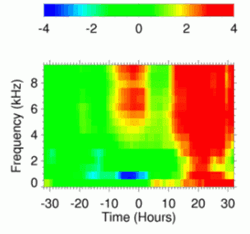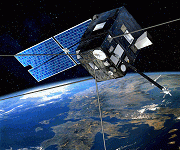11 May 2006
Demeter - listening out for the variations in the electrical field
As the tsunami on 26 December 2004 cruelly reminded us, earthquakes are often the cause of the most deadly natural disasters. Will satellites one day be able to forewarn populations of an imminent earthquake?
This question has been intriguing scientists since 1982, when the French-Russian satellite Aureol 3 1st provided tantalizing new clues: a few hours before they strike, earthquakes appear to be preceded by electrical phenomena that are thought to propagate up into the ionosphere, the layer of electrically charged particles at the top of Earth’s atmosphere.
That is where, at an altitude of more than 600 km, Demeter’s large 4-metre antennas are listening out for the tiniest variations in the planet’s electrical field.
That is where, at an altitude of more than 600 km, Demeter’s large 4-metre antennas are listening out for the tiniest variations in the planet’s electrical field.

This figure shows a drop in the intensity of waves measured by Demeter across a frequency range of 500 Hz to 1 kHz; the drop starts about 10 hrs before earthquakes and continues up to 2 hrs afterwards.
Over the same timeframe, we see an increase in intensity at frequencies between 4 kHz and 10 kHz. A 3rd disturbance is recorded across the full range of frequencies about 24 hrs after quakes.
Results were obtained from 4,385 hrs of data and 2,628 earthquakes at depths above 40 km and with a magnitude higher than 4.8.
An exploratory mission
Pascale Ultré-Guérard, in charge of the solid Earth and geodesy programme at CNES, is more circumspect about the huge hopes raised of detecting earthquakes early in this way: “Demeter is an exploratory mission that has yielded statistical data on thousands of tremors. That was its main objective, to fill in the gaps in more sparsely distributed ground-based measurements.
This large volume of data, which will allow scientists to identify any correlations between earthquakes and disturbances in the ionosphere, is Demeter’s chief achievement.
However, no scientific paper based on these data has yet been published in a peer-reviewed journal, which is a vital step toward validating results, especially on a topic so keenly debated within the scientific community.
It is also essential to understand the origin of such possible tell-tale warning signs.
However, no scientific paper based on these data has yet been published in a peer-reviewed journal, which is a vital step toward validating results, especially on a topic so keenly debated within the scientific community.
It is also essential to understand the origin of such possible tell-tale warning signs.

Alongside its prime science mission, Demeter is also the 1st satellite to fly and test out the Myriade microsatellite bus.
Myriade has proven a great success and the satellite is in excellent shape after nearly 2 years in service—so much so that its mission could be extended for a few months if scientists feel it necessary.
More about
CNES Programmes: Demeter on the CNES website